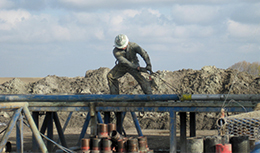
|
Carbonated beverages, fire extinguishers, refrigerants, food packaging, and water treatment are some of the products and processes that make carbon dioxide a common and valuable commodity. CO2 for these uses comes from tapping natural underground reservoirs or from industrial processes involving fermentation or hydrogen production. When CO2 captured from industrial processes is used in place of natural CO2, a net greenhouse gas reduction is realized. New uses for CO2 are being developed to improve the economics of capturing industrial CO2 to achieve lower greenhouse gas emissions. In the WESTCARB region, companies are advancing technologies that use CO2 in building materials and plastics and in the production of biofuels and geothermal energy. Currently, injection of CO2 into some older oil fields to increase production offers a relatively large near-term use for CO2. Referred to as CO2-enhanced oil recovery or CO2-EOR, this approach can extend the life of mature oil fields while providing long-term storage for CO2 left behind in the rock formations after oil field operations cease. CO2-EOR has been ongoing in oil fields in Texas and New Mexico for 40 years. Oil fields suited for CO2-EOR in the WESTCARB region are found predominantly in Alaska and California. Oil companies have tested CO2-EOR in California and have projects awaiting the CO2 from proposed industrial capture projects. Although CO2 utilization technologies may collectively yield substantial greenhouse gas emissions reductions, they do not preclude the need for multiple types of no- or low-carbon technologies, including terrestrial and geologic carbon storage.
|
In addition to greenhouse gas benefits, CO2 utilization technologies can create jobs and contribute to economic growth.
|
